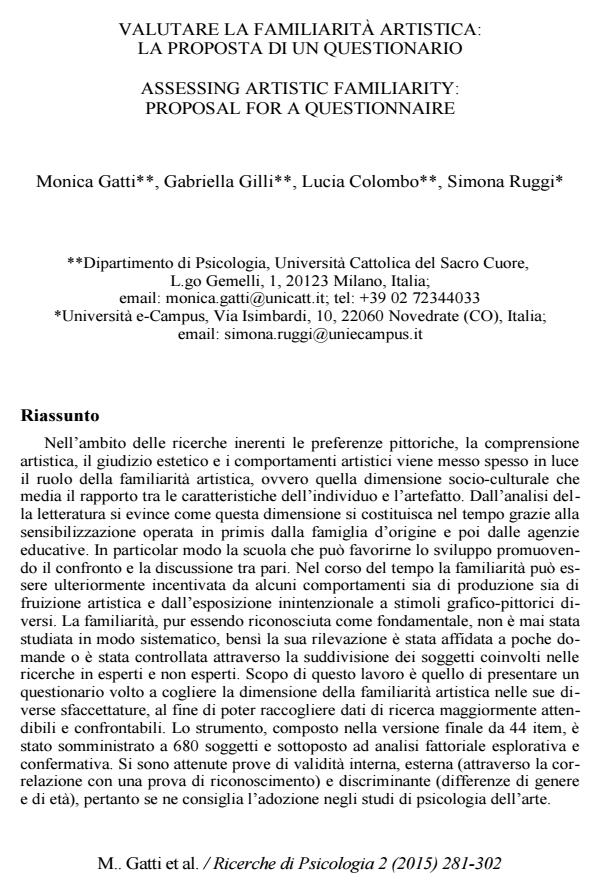Valutare la familiarita artistica: la proposta di un questionario
Titolo Rivista RICERCHE DI PSICOLOGIA
Autori/Curatori Monica Gatti, Gabriella Gilli, Lucia Colombo, Simona Ruggi
Anno di pubblicazione 2015 Fascicolo 2015/2
Lingua Italiano Numero pagine 22 P. 281-302 Dimensione file 203 KB
DOI 10.3280/RIP2015-002001
Il DOI è il codice a barre della proprietà intellettuale: per saperne di più
clicca qui
Qui sotto puoi vedere in anteprima la prima pagina di questo articolo.
Se questo articolo ti interessa, lo puoi acquistare (e scaricare in formato pdf) seguendo le facili indicazioni per acquistare il download credit. Acquista Download Credits per scaricare questo Articolo in formato PDF

FrancoAngeli è membro della Publishers International Linking Association, Inc (PILA)associazione indipendente e non profit per facilitare (attraverso i servizi tecnologici implementati da CrossRef.org) l’accesso degli studiosi ai contenuti digitali nelle pubblicazioni professionali e scientifiche
Nell’ambito delle ricerche inerenti le preferenze pittoriche, la comprensione artistica, il giudizio estetico e i comportamenti artistici viene messo spesso in luce il ruolo della familiarita artistica, ovvero quella dimensione socio-culturale che media il rapporto tra le caratteristiche dell’individuo e l’artefatto. Dall’analisi della letteratura si evince come questa dimensione si costituisca nel tempo grazie alla sensibilizzazione operata in primis dalla famiglia d’origine e poi dalle agenzie educative. In particolar modo la scuola che puo favorirne lo sviluppo promuovendo il confronto e la discussione tra pari. Nel corso del tempo la familiarita puo essere ulteriormente incentivata da alcuni comportamenti sia di produzione sia di fruizione artistica e dall’esposizione inintenzionale a stimoli grafico-pittorici diversi. La familiarita, pur essendo riconosciuta come fondamentale, non e mai stata studiata in modo sistematico, bensi la sua rilevazione e stata affidata a poche domande o e stata controllata attraverso la suddivisione dei soggetti coinvolti nelle ricerche in esperti e non esperti. Scopo di questo lavoro e quello di presentare un questionario volto a cogliere la dimensione della familiarita artistica nelle sue diverse sfaccettature, al fine di poter raccogliere dati di ricerca maggiormente attendibili e confrontabili. Lo strumento, composto nella versione finale da 44 item, e stato somministrato a 680 soggetti e sottoposto ad analisi fattoriale esplorativa e confermativa. Si sono attenute prove di validita interna, esterna (attraverso la correlazione con una prova di riconoscimento) e discriminante (differenze di genere e di eta), pertanto se ne consiglia l’adozione negli studi di psicologia dell’arte.
Parole chiave:Familiarita artistica, questionario,analisi di validita.
Monica Gatti, Gabriella Gilli, Lucia Colombo, Simona Ruggi, Valutare la familiarita artistica: la proposta di un questionario in "RICERCHE DI PSICOLOGIA " 2/2015, pp 281-302, DOI: 10.3280/RIP2015-002001